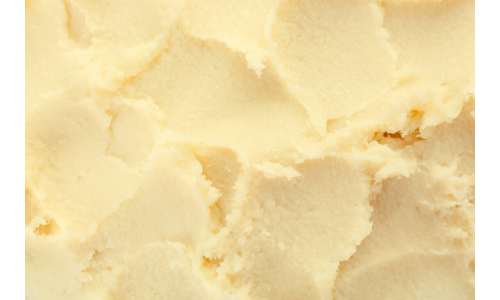Shea Butter (How it’s made?)
Learn about how shea butter is made and the difference between raw, unrefined and refined shea butter.
Shea butter is a fat extract from the shea kernel, a product of the African shea tree (Vitellaria paradoxa formerly Butyrospermum parkii) native to west and east Africa. When the fat is extracted from the nut, it can be processed in various ways making it versatile and useful, both in food preparation and cosmetic products.
Shea butter is primarily composed of fatty acids known as oleic and steric acids both of which have a wide range of effects on human health. Fatty acids help to enhance skin hydration by sealing in skin moisture and reducing evaporation to the surrounding atmosphere. It also combines seamlessly with the natural oils produced by your skin, making it an ideal skin barrier aid. Other beneficial compounds include vitamin A and F which have pro-ageing and moisturising properties, tocopherol also known as vitamin E and catechins which act as antioxidants.
Now let’s get into how its made!
How to make Shea Butter?
The simple answer is with a considerable amount of effort - when you order shea butter, you’re supporting a group of women in Africa who have been trained to make a living handcrafting high-quality shea butter. It would almost be impossible to perfect and surpass what they produce.
But for the overly ambitious, I have researched and found a step-by-step breakdown of how unrefined shea butter is made.
Step 1: Gathering - During the harvesting season (between June and August), fruits that have ripened and fallen to the ground are collected.
Step 2: Boiling - The nuts are separated from the fruit. The nuts are then prepared for boiling.
Step 3: Drying - Nuts are then laid out to dry in the sun. When dried, they are cracked and the nuts are separated from the kernel.
Step 4: Selecting - Good nuts are separated from the bad.
Step 5: Grinding - Good nuts are broken into small pieces by hand or in a mill.
Step 6: Roasting - The ground nuts are then roasted in a rotating oven.
Step 7: Re-grind
The nuts are then ground for a second time. This time producing a chocolate looking paste.
Step 8: Hand mixing - In this step, the paste is mixed by hand. Water is added to the mix, which then creates a reaction that separates the oil from water.
Step 9: Boiling the oil - This shea paste is boiled, causing the oil to rise to the top. It is then skimmed and placed in a separate bowl to cool.
Step 10: Filtering and Stirring - Lastly, to produce unrefined shea butter the oil is put through a fine sieve to filter out unwanted parts. It is then stirred until it increases in thickness and viscosity. Eventually, becoming the infamous solid block of shea butter.
For a visual guide, watch here.
Types of Shea Butter
Raw shea butter contains some impurities (as there is no additional processing/filtering) and has a characteristic smoky smell that comes from the roasting steps. The colour of raw shea butter is usually deep yellow or even greenish if processed shea nuts were not ripe. If shea butter is filtered in any way it is no longer considered raw.
Unrefined shea butter is similar to raw shea butter. However, the difference is basic - the added filtering step. Unrefined shea butter can be filtered as long as the filtering methods don’t affect its quality.
Refined shea butter is white and odourless. The refining process uses high levels of heat, removing the colour, scent and most of its beneficial properties.
There you have it. A breakdown on how shea butter is made, did it meet your expectations?
Do you prefer raw, refined or unrefined?


